When I started growing dahlias I had no idea that you could grow them from seed. It was actually a good 10 years into my journey with them that I learned that there was a difference between growing dahlias from tubers or cuttings, which is how you clone a variety, and growing them from seed, which is how you create or breed a brand new variety.
Once I dipped a toe into growing dahlias from seed (i.e. breeding), I got completely swept up in the process and it has since become a huge part of my life. It’s funny how my little side weekend projects inevitably become the next big thing we’re working on. And dahlia breeding certainly falls into that camp.
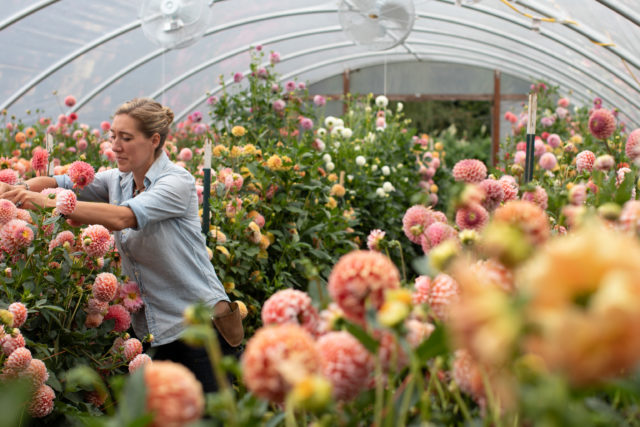 The first year I learned about how to breed new varieties, I collected some seed pods from my favorite varieties in the field and the hoop houses (‘Café au Lait’, ‘Appleblossom’, ‘Peaches N’ Cream’, and ‘Waltzing Mathilda’) and saved them aside to grow out the following season.
The first year I learned about how to breed new varieties, I collected some seed pods from my favorite varieties in the field and the hoop houses (‘Café au Lait’, ‘Appleblossom’, ‘Peaches N’ Cream’, and ‘Waltzing Mathilda’) and saved them aside to grow out the following season.
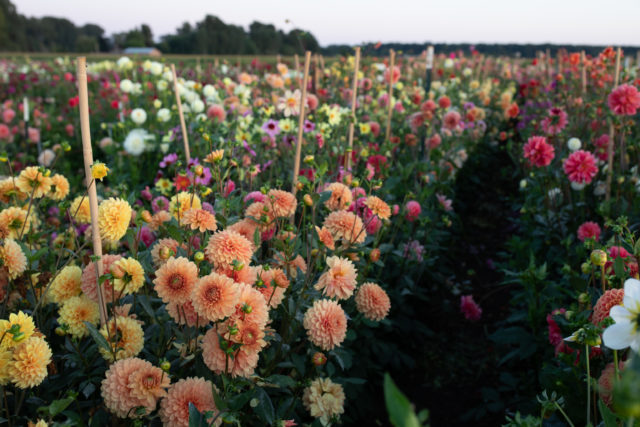 My first dahlia seedling patch consisted of a single bed (a few hundred plants) tucked in my backyard, and of all the things I grew that season that one little row was by far the most exciting.
My first dahlia seedling patch consisted of a single bed (a few hundred plants) tucked in my backyard, and of all the things I grew that season that one little row was by far the most exciting.
Waiting for each new flower to open to see what emerged became addicting and I just couldn’t get enough.
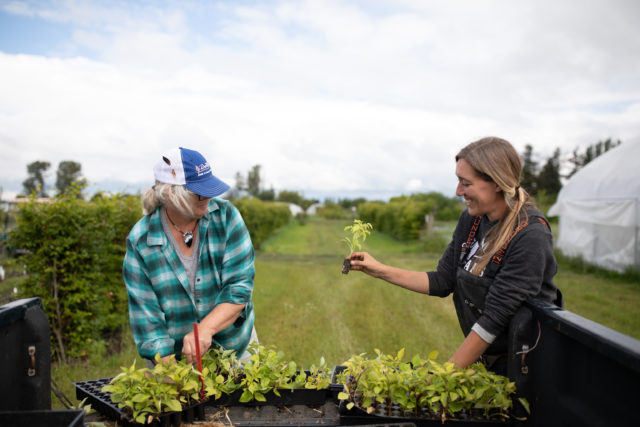
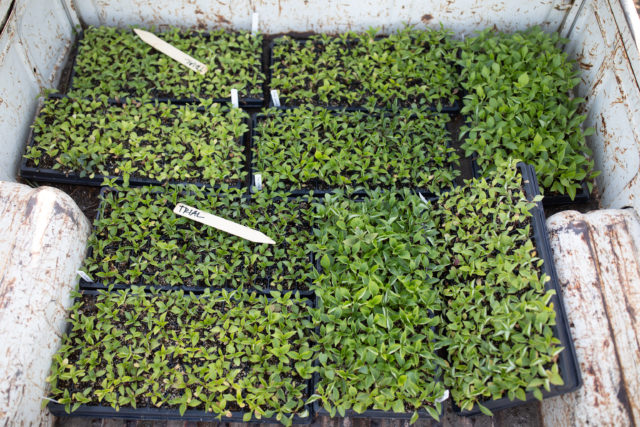
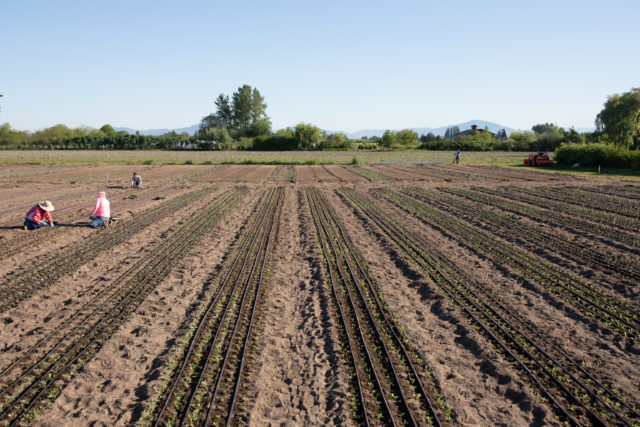 That season I collected as many seeds as I possibly could, and the following season we had enough to plant out a patch of 13,000 seedlings—an entire field block. It is probably one of the most beautiful things I’ve ever grown!
That season I collected as many seeds as I possibly could, and the following season we had enough to plant out a patch of 13,000 seedlings—an entire field block. It is probably one of the most beautiful things I’ve ever grown!
If you want to learn how to collect seeds off of your dahlias and breed new varieties, we dedicated an entire chapter to the subject in Discovering Dahlias, starting on page 88.
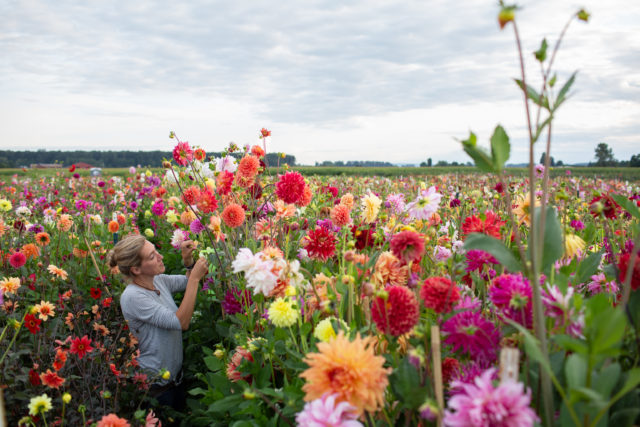
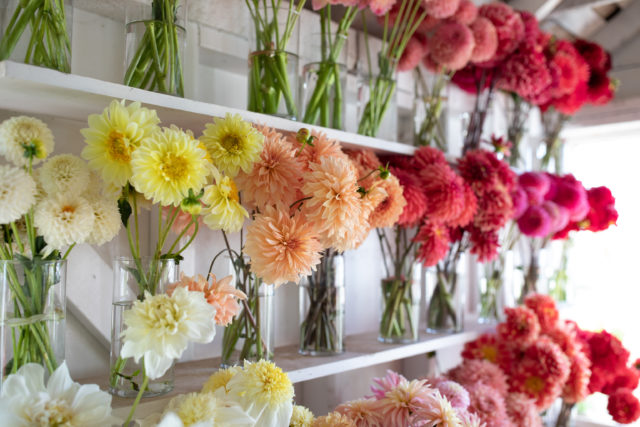
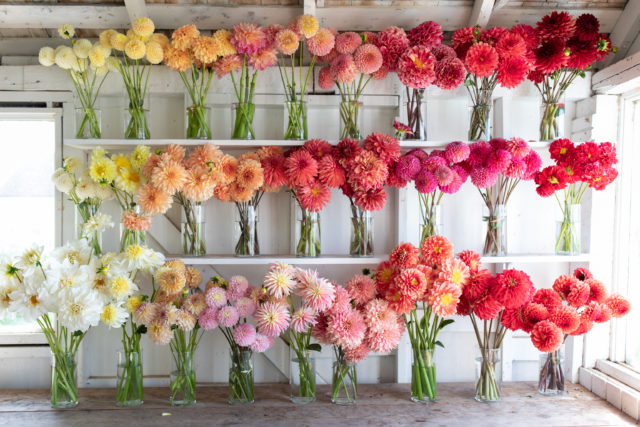 Out of those 13,000 seedlings I ended up with about 500 promising varieties that I flagged, dug, divided, and saved to observe the following year.
Out of those 13,000 seedlings I ended up with about 500 promising varieties that I flagged, dug, divided, and saved to observe the following year.
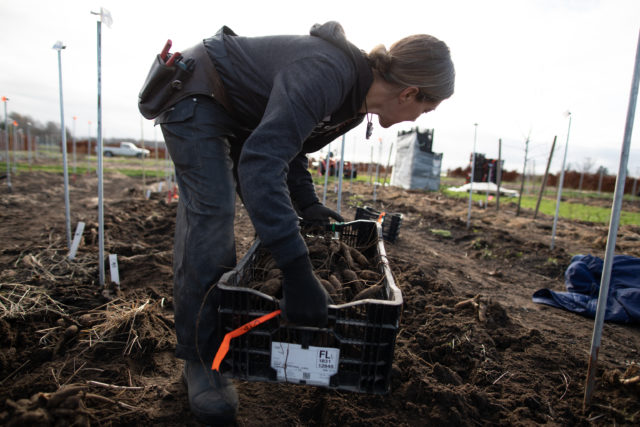
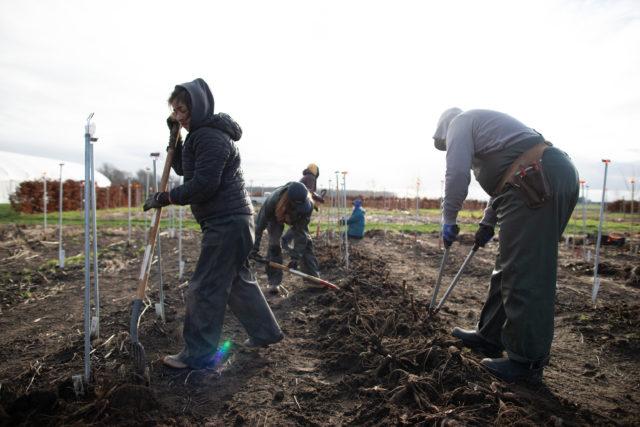 I approach dahlia breeding like one giant treasure hunt. No matter how much you try to guide them in a direction (hand crossing, isolating breeding pairs, bagging individual blooms) in the end you don’t really know what you’re going to get. Most of the dahlia breeders I’ve talked to only save one out of every hundred seedlings they grow, often even less.
I approach dahlia breeding like one giant treasure hunt. No matter how much you try to guide them in a direction (hand crossing, isolating breeding pairs, bagging individual blooms) in the end you don’t really know what you’re going to get. Most of the dahlia breeders I’ve talked to only save one out of every hundred seedlings they grow, often even less.
Simply put, it’s a numbers game.
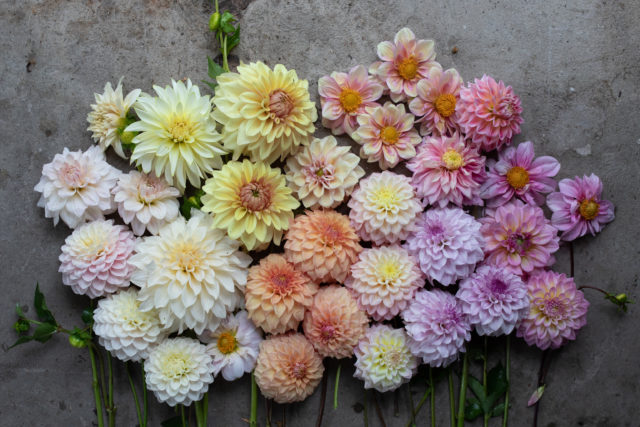
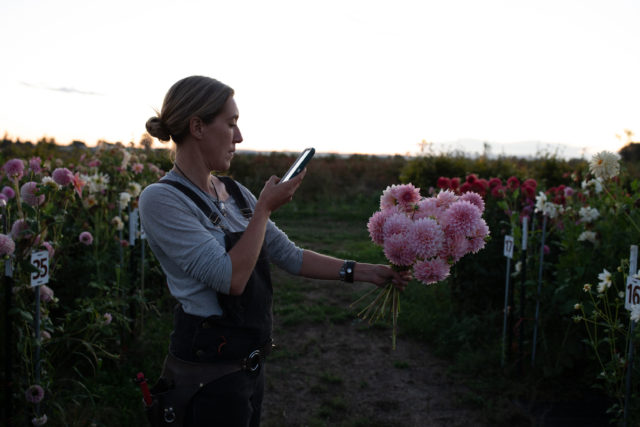 Over the last few years, as I’ve gotten deeper into the process, I’ve really tried to focus my efforts. I’m looking for varieties that have unusual colors and forms, making them ideal for flower arranging and design work. To me, color is the most important quality and then form or shape is the second.
Over the last few years, as I’ve gotten deeper into the process, I’ve really tried to focus my efforts. I’m looking for varieties that have unusual colors and forms, making them ideal for flower arranging and design work. To me, color is the most important quality and then form or shape is the second.
Good stem length is also very important along with vigorous growth and good plant health.
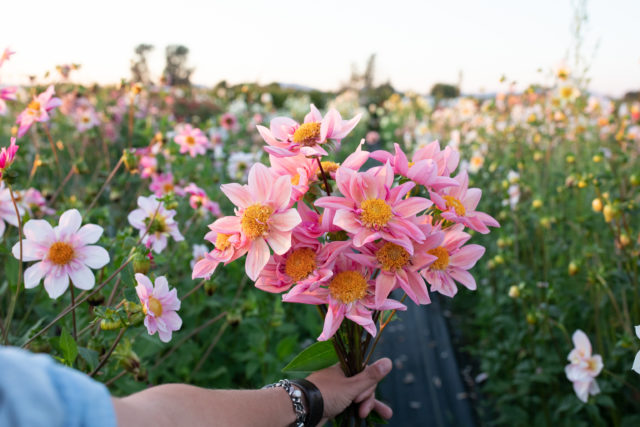
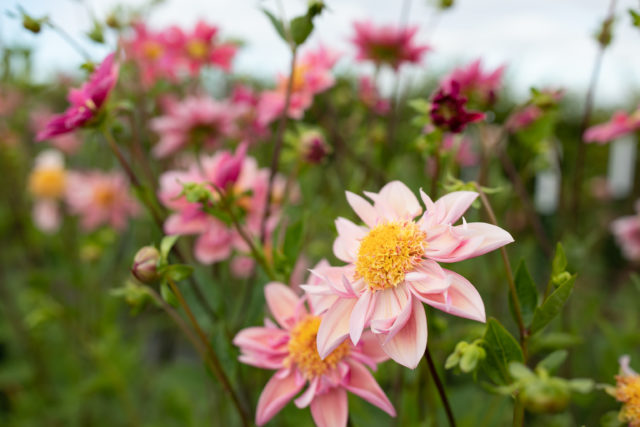 Finding all of these qualities in one single variety is nearly impossible so tens of thousands of seedlings have ended up in the compost pile because they don’t meet all of my criteria.
Finding all of these qualities in one single variety is nearly impossible so tens of thousands of seedlings have ended up in the compost pile because they don’t meet all of my criteria.
I know that sounds harsh, but if I kept every variety (and they all are beautiful in their own way), there’s just no way that we could ever manage that volume of work, so I find that it’s important to be very selective and try and stay as true as possible to my breeding goals each season.
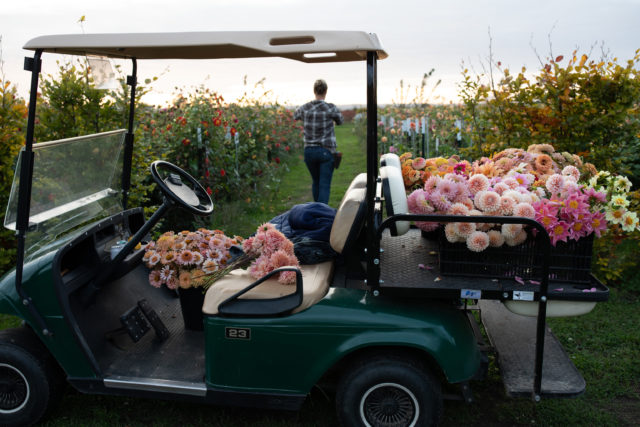
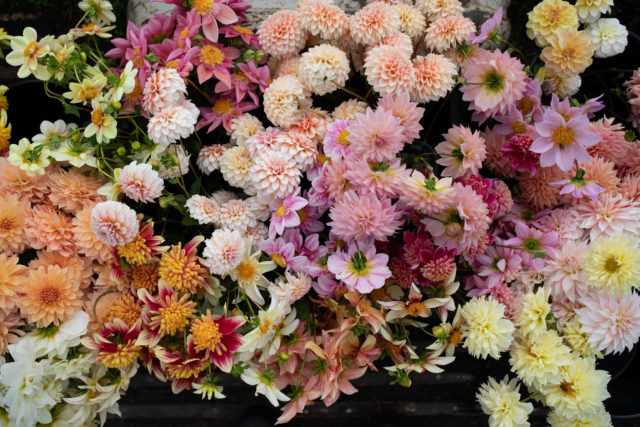 Traditionally, dahlia breeders have mainly focused their breeding efforts on varieties that will rank high in competition, with the exception of Kristine Albrecht at Santa Cruz Dahlias who has bred some incredible varieties perfect for arranging.
Traditionally, dahlia breeders have mainly focused their breeding efforts on varieties that will rank high in competition, with the exception of Kristine Albrecht at Santa Cruz Dahlias who has bred some incredible varieties perfect for arranging.
If you don’t already have Kristine’s wonderful book, Dahlia Breeding for the Farmer-Florist and the Home Gardener, it’s a must-add to your library if you’re interested in dahlia breeding. She also shares wonderful short video tutorials over on Instagram and has a great website.
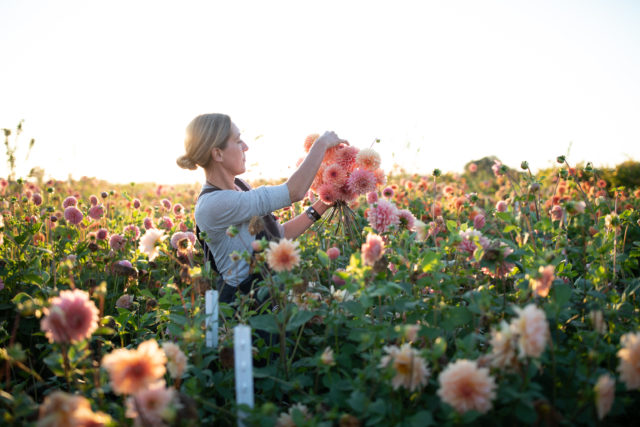
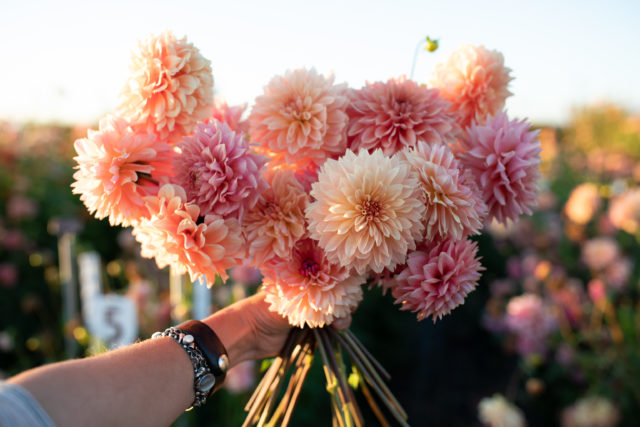 When it comes to variety selection, I’ve found that I’m drawn to the oddballs with muted coloring, unusual forms, and stems that sway in the breeze.
When it comes to variety selection, I’ve found that I’m drawn to the oddballs with muted coloring, unusual forms, and stems that sway in the breeze.
None of the varieties that are in my breeding patch will likely ever win a blue ribbon at a dahlia show, but I think flower arrangers, farmers, and gardeners will love them, and that is who these magical varieties are intended for.
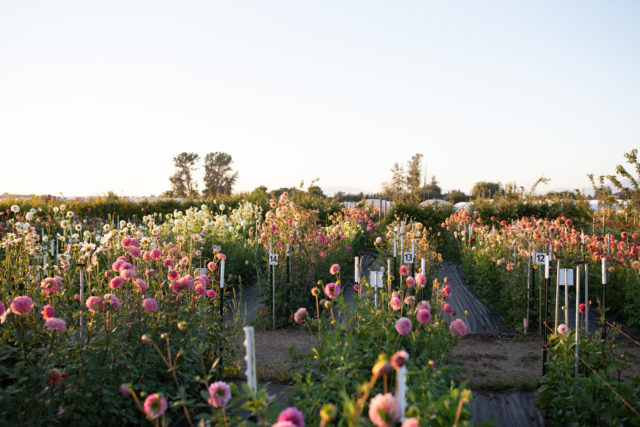
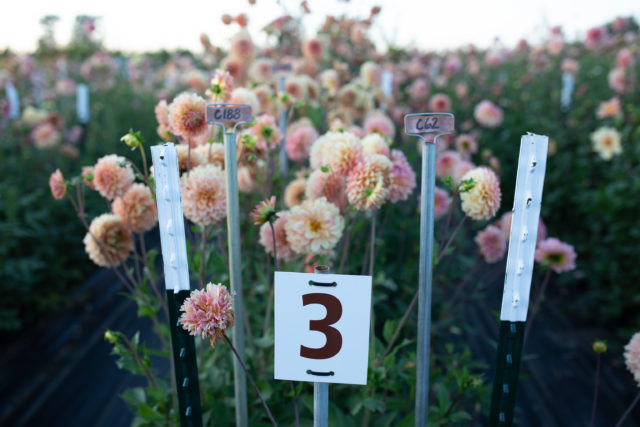 This past season it became really clear that the dahlia breeding project had ballooned to the point that it was in serious need of some focused attention and thoughtful organization. We hunkered down and mapped everything out with a ton of detail. Each row was numbered, every variety labeled at eye level and then detailed maps were drawn up.
This past season it became really clear that the dahlia breeding project had ballooned to the point that it was in serious need of some focused attention and thoughtful organization. We hunkered down and mapped everything out with a ton of detail. Each row was numbered, every variety labeled at eye level and then detailed maps were drawn up.
Up until that point, I had been working on the project in the fringe hours mostly by myself, but with close to 500 varieties to manage, I needed to call in reinforcements.
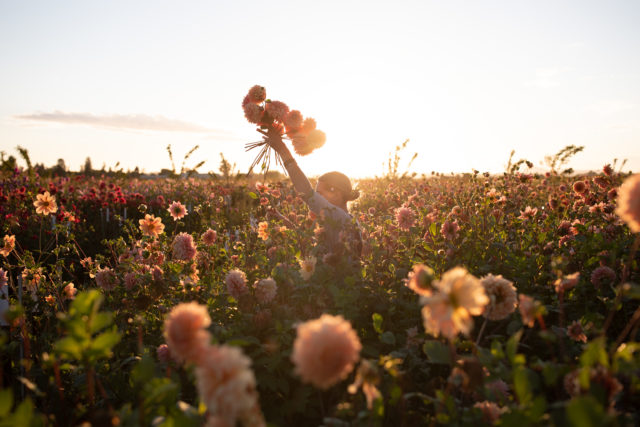
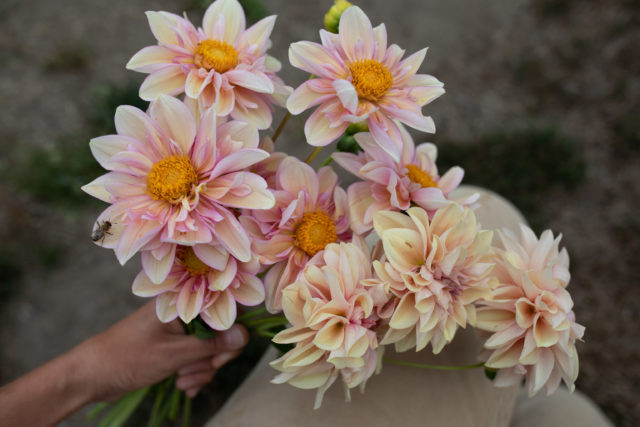 So Jill, Nina, Chris, and I spent the season organizing, observing, documenting, photographing, and cataloging all of the varieties in this project.
So Jill, Nina, Chris, and I spent the season organizing, observing, documenting, photographing, and cataloging all of the varieties in this project.
It was a massive organizational feat, but I’m so happy we gave these varieties the focused attention that they deserve.
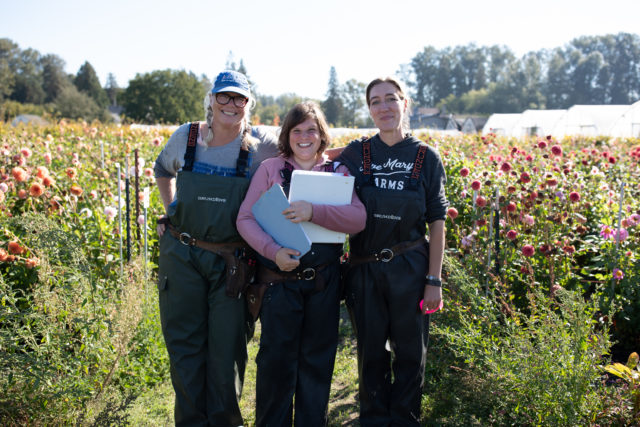
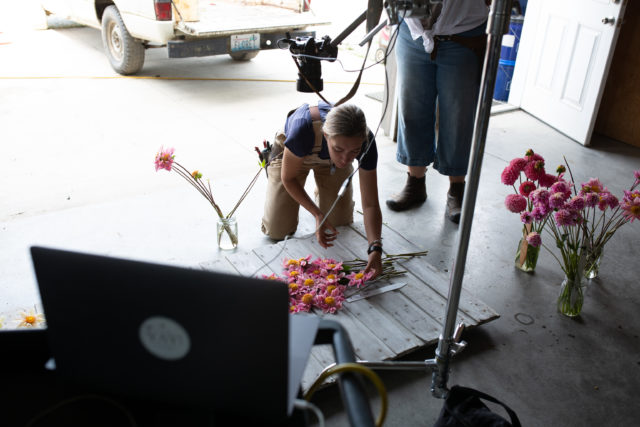 Twice a week from mid-July to early October we walked the rows, observed the plants, selected which varieties would move forward, harvested flowers from the varieties that made the cut, measured blooms, wrote descriptions in our big breeding binders, and brought them into the barn to have their portrait taken.
Twice a week from mid-July to early October we walked the rows, observed the plants, selected which varieties would move forward, harvested flowers from the varieties that made the cut, measured blooms, wrote descriptions in our big breeding binders, and brought them into the barn to have their portrait taken.
Here is a little sampling of the flower portraits:
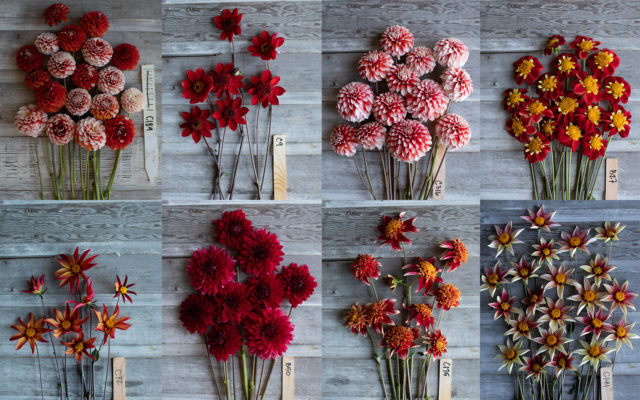
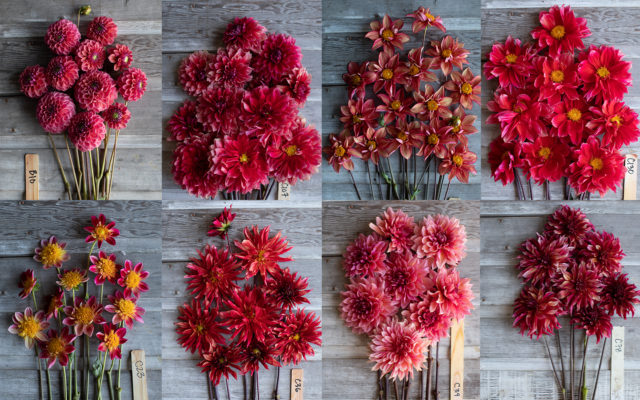
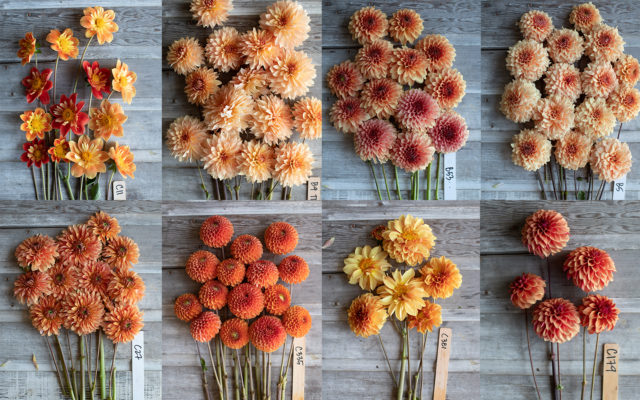
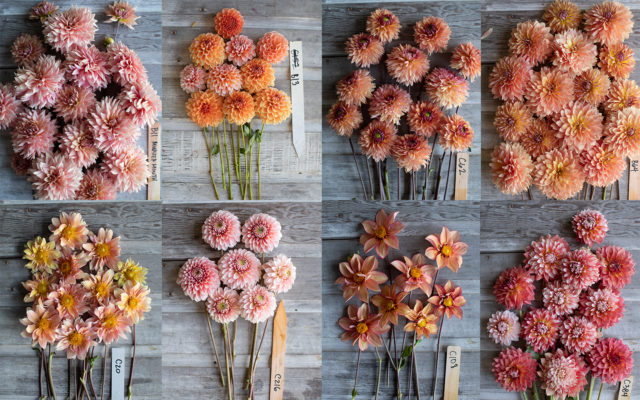
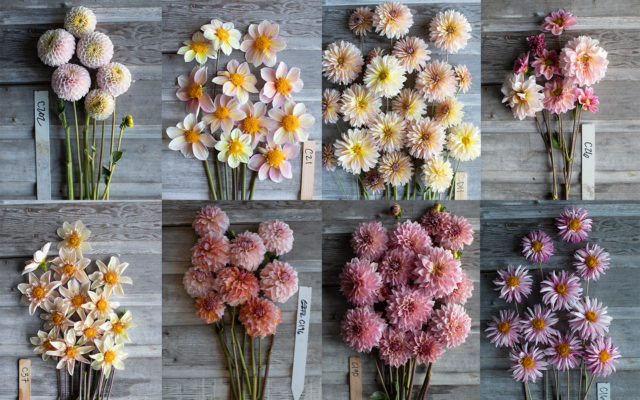
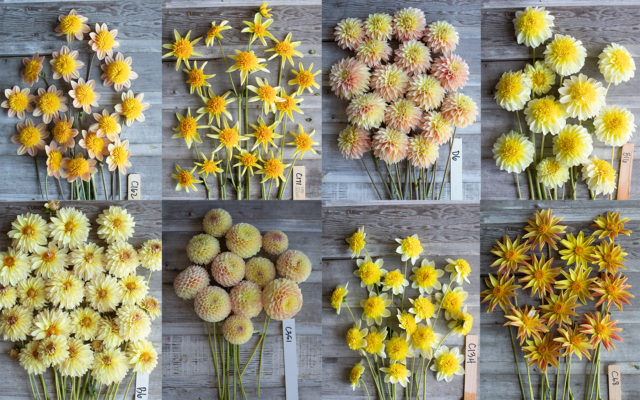
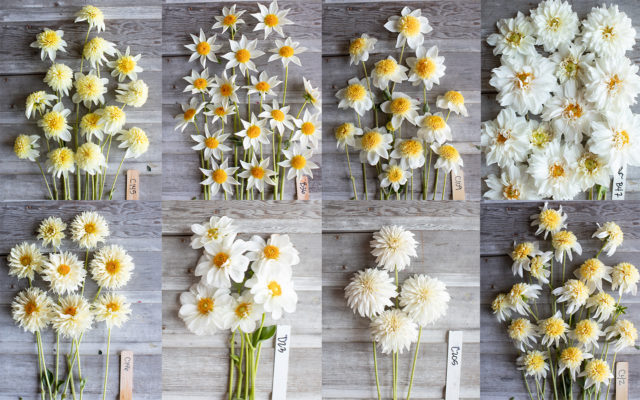
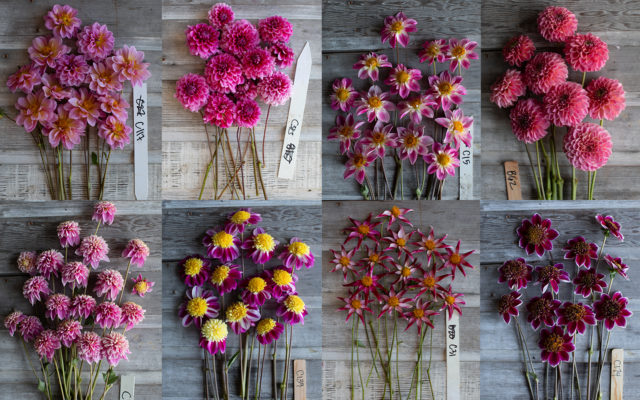 There are so many beautiful little treasures emerging from this project and looking at them all leaves me a bit overwhelmed, in the best possible way.
There are so many beautiful little treasures emerging from this project and looking at them all leaves me a bit overwhelmed, in the best possible way.
Three top favorites are:
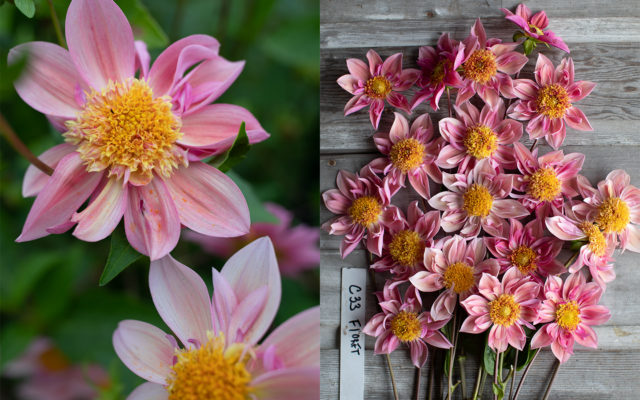 C33/Floret is one of the sweetest varieties I’ve ever grown. The large glowing pink outer petals encircle a smaller row of lighter pink inner petals that are layered and twisted. As flowers age, the golden centers grow fluffy and outer petals fade to soft apricot.
C33/Floret is one of the sweetest varieties I’ve ever grown. The large glowing pink outer petals encircle a smaller row of lighter pink inner petals that are layered and twisted. As flowers age, the golden centers grow fluffy and outer petals fade to soft apricot.
This was her third year growing and the tuber count is now 154.
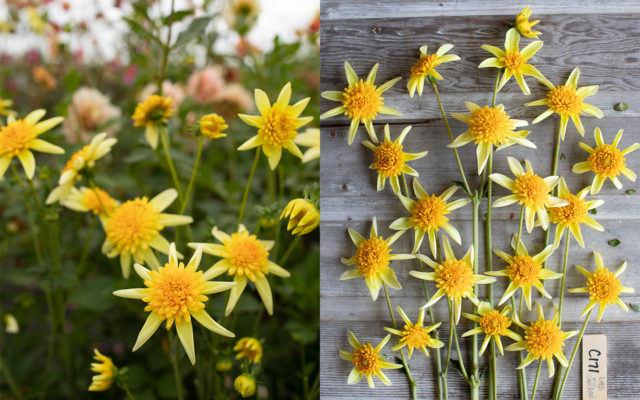 C171/Little Miss Sunshine looks exactly like a kids’ illustration of a sun. Flowers are a glowing clean lemon yellow with domed puffy centers. Plants have a branching habit and each stem has a ton of flowers. I’ve never seen anything like it!
C171/Little Miss Sunshine looks exactly like a kids’ illustration of a sun. Flowers are a glowing clean lemon yellow with domed puffy centers. Plants have a branching habit and each stem has a ton of flowers. I’ve never seen anything like it!
This was her second season on the farm and she already produced 72 tubers.
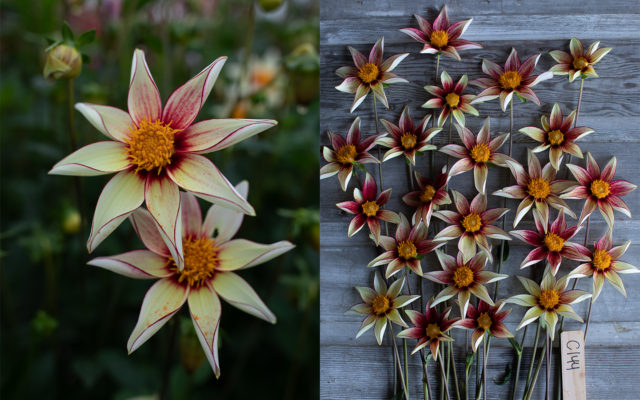 C144/Firefly has pointed slightly incurved petals that are soft buttercream brushed with raspberry-red. They have long wiry stems and the plants are covered in flowers all season long. Pollinators love this variety and it also has surprisingly good tuber production.
C144/Firefly has pointed slightly incurved petals that are soft buttercream brushed with raspberry-red. They have long wiry stems and the plants are covered in flowers all season long. Pollinators love this variety and it also has surprisingly good tuber production.
This was its second year and we already have 51 tubers.
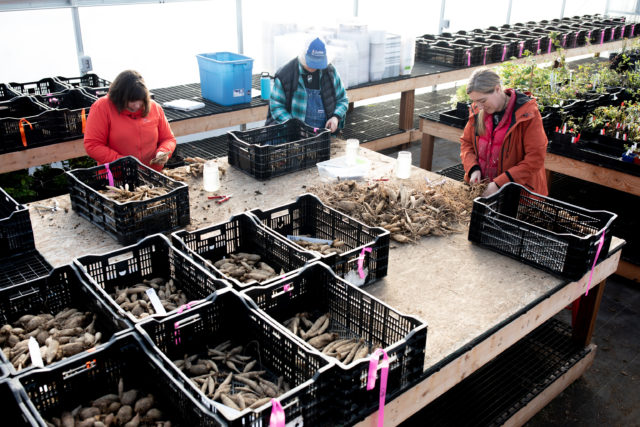
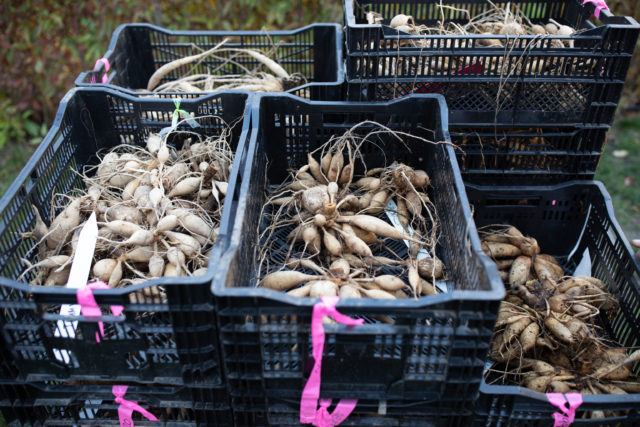 A few weeks ago we finished the massive project of dividing all of the breeding tubers and I’m still in shock over just how well they did.
A few weeks ago we finished the massive project of dividing all of the breeding tubers and I’m still in shock over just how well they did.
In all, we ended up with 9,953 tubers from 215 different varieties!
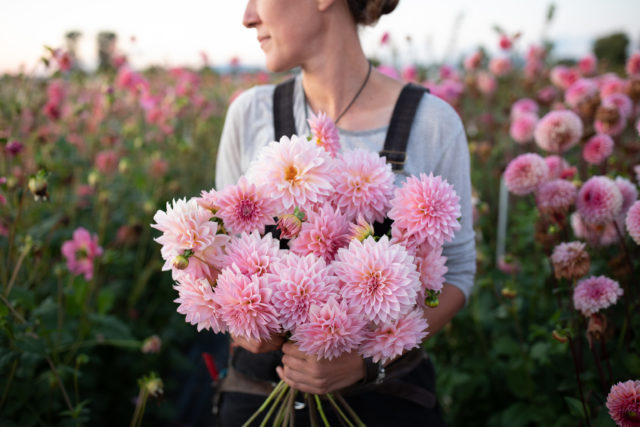
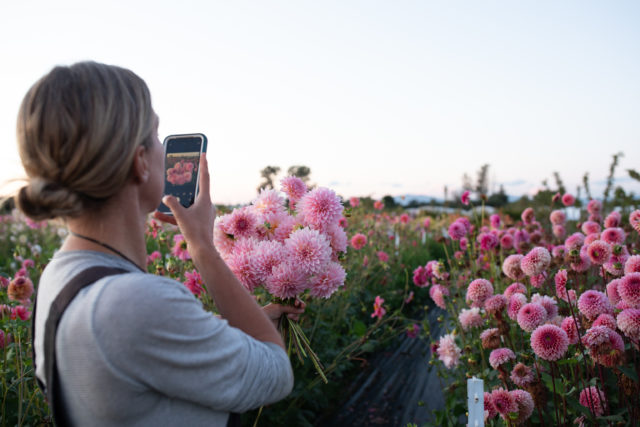 I’ve been asked by so many people that if we’re no longer offering dahlia tubers for sale, why have I invested so much energy and so many years into breeding new varieties? I always feel a little nervous answering this question since this project is still unfolding.
I’ve been asked by so many people that if we’re no longer offering dahlia tubers for sale, why have I invested so much energy and so many years into breeding new varieties? I always feel a little nervous answering this question since this project is still unfolding.
I know I want these special varieties to find their way out into the world someday (when they’re ready), but I’m not sure how that will happen just yet—whether we take on the task of producing and shipping the tubers ourselves or we work with other growers to bring them to market.
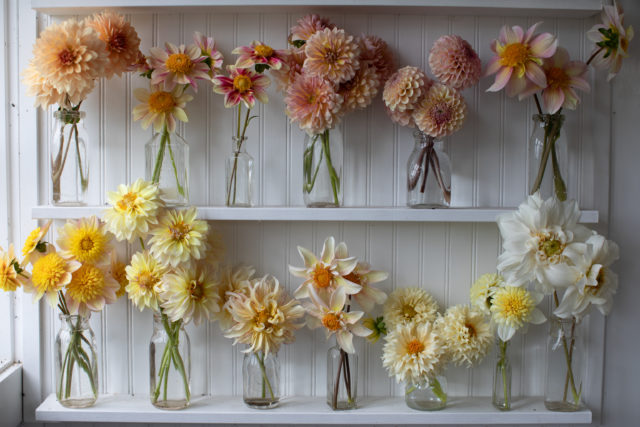
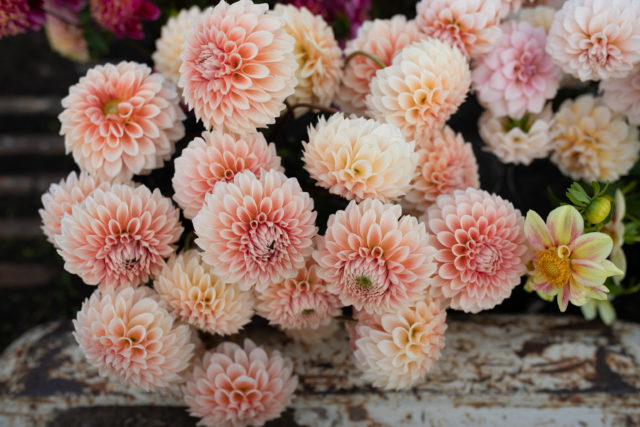 But the real (and probably most important) reason that I’m doing this is that it brings me so much freaking joy.
But the real (and probably most important) reason that I’m doing this is that it brings me so much freaking joy.
I’m so incredibly grateful for the opportunity to get to discover all of these little flower beings, help bring them into the world, and just be along for their ride, wherever it may go.
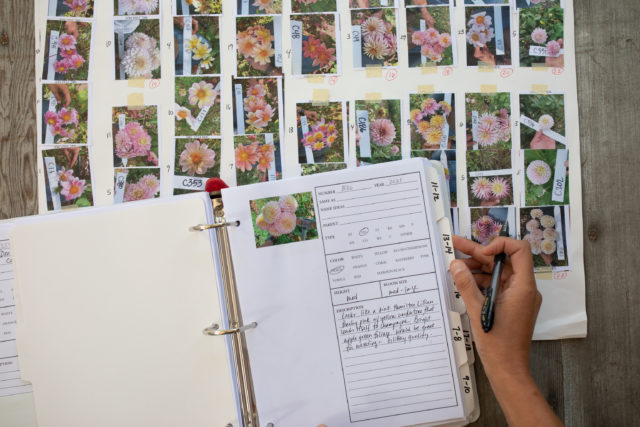
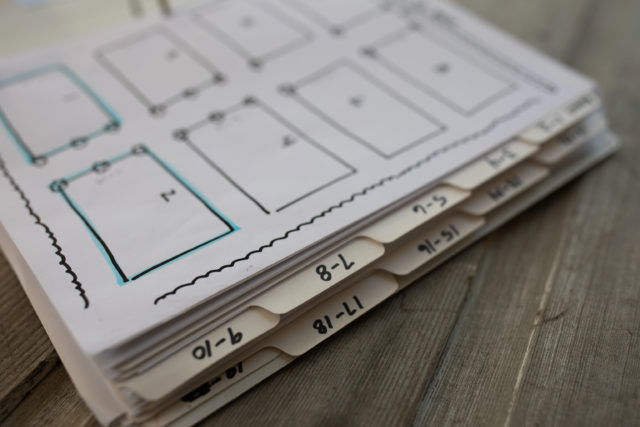 This next season I want to devote more time to working with these varieties and continue refining the collection and our record-keeping process.
This next season I want to devote more time to working with these varieties and continue refining the collection and our record-keeping process.
I want to measure each variety’s vase life, photograph them in the field, and see which varieties are the most suitable for arranging and which ones are better in the garden.
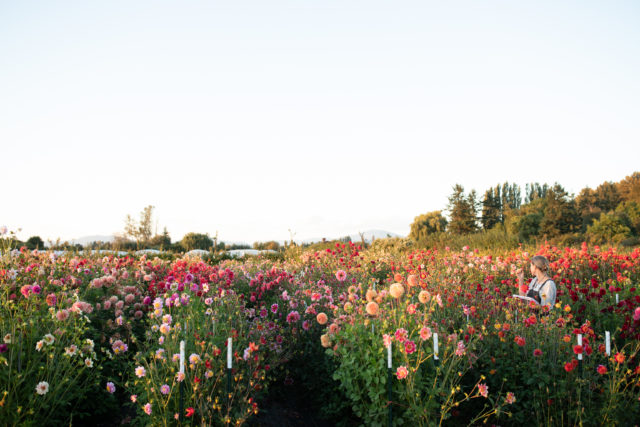
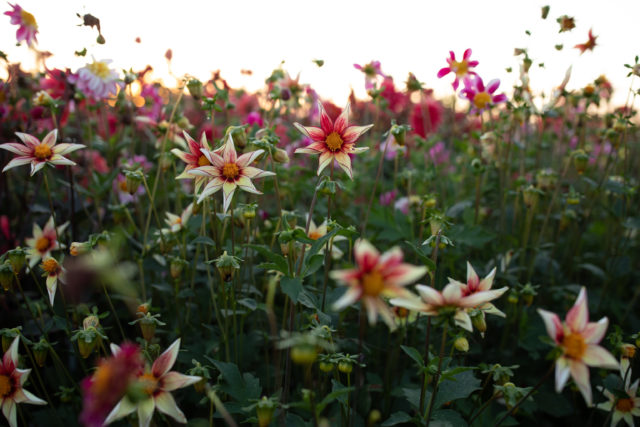 I’m also planning on growing another big seedling patch to see what new treasures I can discover. While I’d love to fill another entire field block, I don’t know if I’ll have the time to observe as many so I’m capping the seedling patch at 7,000 seedlings, which is still plenty.
I’m also planning on growing another big seedling patch to see what new treasures I can discover. While I’d love to fill another entire field block, I don’t know if I’ll have the time to observe as many so I’m capping the seedling patch at 7,000 seedlings, which is still plenty.
When I started this little side project I had no idea that it would turn into what it is today. And what’s so funny is that I feel like this is just the tip of the iceberg and I can’t believe how many varieties I’ve discovered in a relatively short amount of time.
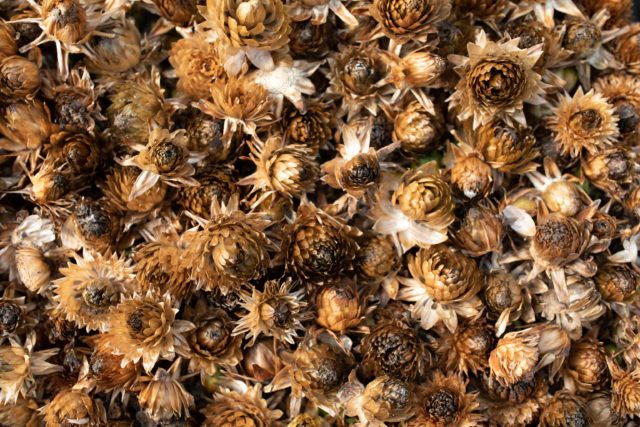
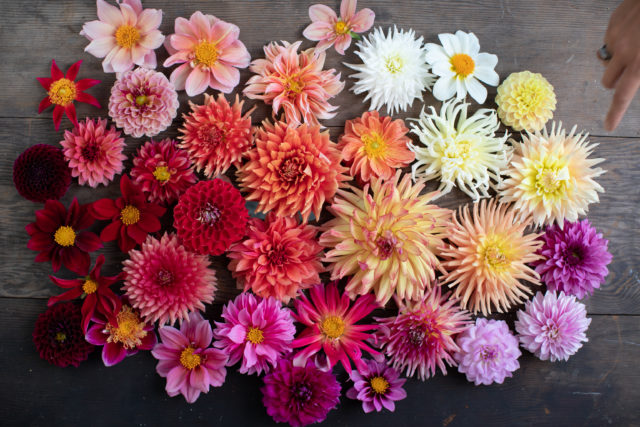 If you’ve never grown dahlias from seed before, then I encourage you to give it a try. If you can’t get your hands on any seeds this season then be sure to leave a few blooms on your dahlia plants and let them go to seed so you can collect them in the fall for planting next spring. See our Recommended Dahlia Sources post for a list of our favorite tuber suppliers.
If you’ve never grown dahlias from seed before, then I encourage you to give it a try. If you can’t get your hands on any seeds this season then be sure to leave a few blooms on your dahlia plants and let them go to seed so you can collect them in the fall for planting next spring. See our Recommended Dahlia Sources post for a list of our favorite tuber suppliers.
Growing dahlias from seed really is the ultimate treasure hunt! You never know, you may discover the next ‘Café au Lait’ blooming in your backyard.
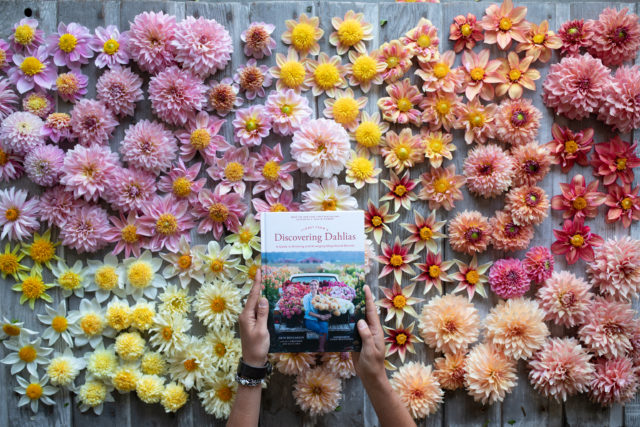 Since this week marks the one-year anniversary of Discovering Dahlias being published, I thought it would be fun to give away five breeding-inspired goody boxes. Each box will include a signed copy of Discovering Dahlias, five packets of dahlia seed from my breeding patch, and a copy of Kristine Albrecht’s wonderful book Dahlia Breeding for the Farmer-Florist and the Home Gardener.
Since this week marks the one-year anniversary of Discovering Dahlias being published, I thought it would be fun to give away five breeding-inspired goody boxes. Each box will include a signed copy of Discovering Dahlias, five packets of dahlia seed from my breeding patch, and a copy of Kristine Albrecht’s wonderful book Dahlia Breeding for the Farmer-Florist and the Home Gardener.
To enter to win, please tell us what your dream dahlia would look like. What would you be thrilled to find in your seedling patch? The five winners will be announced here on Tuesday, March 15.
Update: A big congratulations to our winners Melissa, Megan Fischer, Laura Flournoy, Michelle and Janet.
Please note: If your comment doesn’t show up right away, sit tight; we have a spam filter that requires we approve comments before they are published.
Floret only lists companies and products that we love, use, and recommend. All opinions expressed here are our own and Floret does not offer sponsored content or accept money for editorial reviews. If you buy something using the retail links in this post, Floret may receive a small commission. Thank you for your support!
The post Dahlia Breeding Update appeared first on Floret Flowers.
Once I dipped a toe into growing dahlias from seed (i.e. breeding), I got completely swept up in the process and it has since become a huge part of my life. It’s funny how my little side weekend projects inevitably become the next big thing we’re working on. And dahlia breeding certainly falls into that camp.


Waiting for each new flower to open to see what emerged became addicting and I just couldn’t get enough.



If you want to learn how to collect seeds off of your dahlias and breed new varieties, we dedicated an entire chapter to the subject in Discovering Dahlias, starting on page 88.





Simply put, it’s a numbers game.


Good stem length is also very important along with vigorous growth and good plant health.


I know that sounds harsh, but if I kept every variety (and they all are beautiful in their own way), there’s just no way that we could ever manage that volume of work, so I find that it’s important to be very selective and try and stay as true as possible to my breeding goals each season.


If you don’t already have Kristine’s wonderful book, Dahlia Breeding for the Farmer-Florist and the Home Gardener, it’s a must-add to your library if you’re interested in dahlia breeding. She also shares wonderful short video tutorials over on Instagram and has a great website.


None of the varieties that are in my breeding patch will likely ever win a blue ribbon at a dahlia show, but I think flower arrangers, farmers, and gardeners will love them, and that is who these magical varieties are intended for.


Up until that point, I had been working on the project in the fringe hours mostly by myself, but with close to 500 varieties to manage, I needed to call in reinforcements.


It was a massive organizational feat, but I’m so happy we gave these varieties the focused attention that they deserve.


Here is a little sampling of the flower portraits:








Three top favorites are:

This was her third year growing and the tuber count is now 154.

This was her second season on the farm and she already produced 72 tubers.

This was its second year and we already have 51 tubers.


In all, we ended up with 9,953 tubers from 215 different varieties!


I know I want these special varieties to find their way out into the world someday (when they’re ready), but I’m not sure how that will happen just yet—whether we take on the task of producing and shipping the tubers ourselves or we work with other growers to bring them to market.


I’m so incredibly grateful for the opportunity to get to discover all of these little flower beings, help bring them into the world, and just be along for their ride, wherever it may go.


I want to measure each variety’s vase life, photograph them in the field, and see which varieties are the most suitable for arranging and which ones are better in the garden.


When I started this little side project I had no idea that it would turn into what it is today. And what’s so funny is that I feel like this is just the tip of the iceberg and I can’t believe how many varieties I’ve discovered in a relatively short amount of time.


Growing dahlias from seed really is the ultimate treasure hunt! You never know, you may discover the next ‘Café au Lait’ blooming in your backyard.

To enter to win, please tell us what your dream dahlia would look like. What would you be thrilled to find in your seedling patch? The five winners will be announced here on Tuesday, March 15.
Update: A big congratulations to our winners Melissa, Megan Fischer, Laura Flournoy, Michelle and Janet.
Please note: If your comment doesn’t show up right away, sit tight; we have a spam filter that requires we approve comments before they are published.
Floret only lists companies and products that we love, use, and recommend. All opinions expressed here are our own and Floret does not offer sponsored content or accept money for editorial reviews. If you buy something using the retail links in this post, Floret may receive a small commission. Thank you for your support!
The post Dahlia Breeding Update appeared first on Floret Flowers.
